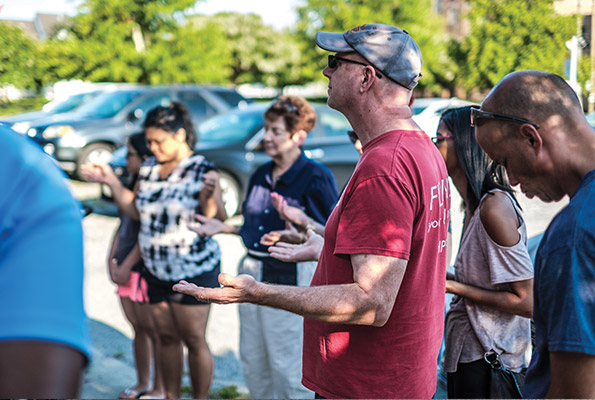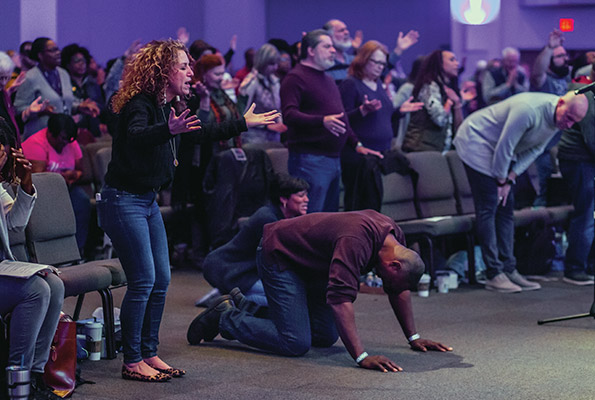For nearly 25 years, prayer has served as the backbone of our church. The phrase we often use, “We can do a lot of things other than pray, but we can’t do anything until we pray,” forms the foundation for how we approach life, ministry, and our role in heaven’s plan according to Scripture. We firmly believe that when we pray, Heaven moves.
Every year for the past 25 years, we’ve taken a break from our regular church schedule to reestablish our rhythm and dependence on prayer. We halt everything to return to our place of prayer, reminding ourselves that without prayer, nothing will happen.
This January, we embark on this journey into a deeper sense of prayer once again.
The theme for this year’s month of prayer is “Amen.” Many of us have uttered this word repeatedly over meals, in our cars, during church services, and elsewhere. However, in some ways, we may have lost our understanding of this word, or perhaps we never fully grasped it in the first place. “Amen” literally means “do it again” or “let it be so.” When we say this word after prayers and in the context of worship services, we are essentially expressing a desire for all the promises of God that we hold dear to be fulfilled in our lives.
We say “Amen” with confidence, in moments of desperation, in tearful thanksgiving, and with childlike expectation. Regardless of the circumstances, each time we utter “Amen,” we are tapping into Heaven’s desire for us.
The goal of the month of prayer is to rekindle our dependence on prayer, rediscover the wonder of our gathered church and prayer meetings, and reignite our personal prayer moments. The logistics for this month are straightforward: a weekly podcast discussing elements of prayer, a daily blog starting on January 8th, weekly prayer gatherings at our campuses and in small groups, prayer resources for adults and families, and churchwide prayer gatherings at the beginning, middle, and end of the month.
We kicked off this month of prayer on December 31 alongside Big House Church with a night of corporate prayer and worship, marking the transition into the new year with a fresh spiritual consecration. We will conclude our month of prayer on February 3 with a five-hour prayer summit.
However you choose to engage with this month, we pray that something in your soul encounters the Lord in a place of prayer. Let’s contend together and witness every promise He has for us manifest as a season of fulfillment. May we all shout, “Amen!”


Weekly Prayer Gatherings
Monday
Tuesday
6:45p
Ghent
Wednesday
6:30a
Kempsville
12:00p
Kempsville & Deep Creek
Thursday
12:00p
Town Center via Zoom (Join Here)
Friday
6:30a
Deep Creek
Saturday
5:30p
Kempsville
Sunday
8:30a
Kempsville
Town Center
9:30a
Deep Creek
Ghent
As we pray for 21 days, our plans for our prayer time can vary, maybe including worship music, Bible reading, and quiet time to listen to God. It doesn’t always have to look the same; it just helps when we have a plan for connecting regularly with God. Below are four different models of prayer that you could try:
Prayer is not only communion with God; it is also confrontation with the enemy. When Jesus was on the earth, He came face-to-face with the devil when He was tempted in the wilderness (see Matthew 4 and Luke 4), and every time the enemy tried to tempt Him, Jesus responded with a reference from the Bible. He used the Sword of Truth to defend Himself from the enemy’s attacks. In these exchanges, Jesus didn’t confront the devil as God. He confronted the devil as a man with the Word of God. We should do the same thing. Prayers of warfare are meant to directly challenge the attacks of the enemy. During these 21 days of prayer, specifically pray for those places in your life where you are attacked and use scripture to undergird your prayers.
The Word of God is one of the most valuable tools we have to build a dynamic daily prayer life. It brings power, truth, and encouragement to our prayer time. As you pray over the next 21 days, find scriptures that encourage and uplift, and pray to God using His word. The power and truth found in God’s word will not return void.
In the Old Testament, the Tabernacle was the dwelling place of God, built to His specifications, where He would meet His people. As they entered the Tabernacle, they passed through seven stations, following God’s instructions, to experience His presence. Today, even though we no longer need the physical Tabernacle to meet with God, these same steps can help us connect with Him.
- The Israelites entered the Tabernacle with thanksgiving and praise, and we start our prayer time the same way.
- In the Old Testament, everyone had to regularly bring animal sacrifices as payment for their sins. Today, we don’t have to do that because Jesus paid for our sins once and for all with His blood on the cross. We continue our prayer, thanking him for the gift of salvation.
- The next step in the Tabernacle was a bowl of water where people were reminded of their sinfulness and their need to be cleansed and forgiven by God. Checking our hearts and motives and surrendering our lives to God is an important part of daily prayer. We use this portion of the prayer to confess our sins.
- The next piece of the Tabernacle was a seven-branched golden candlestick. The fire represents the Holy Spirit and how we are called to be light in the world’s darkness. In this portion of the prayer, we pray for empowerment and transformation through the Holy Spirit.
- In the Tabernacle, a table with twelve loaves of bread represented the importance of reading God’s Word for daily sustenance. Use this portion of the prayer time to incorporate God’s Word.
- A small altar of burning incense stood at the entrance to the Holy of Holies, where God’s presence dwelled. The people of God entered God’s presence as they worshipped His names. This altar represents worship and the pleasure it gives God when we worship Him. Thank God for making His presence available to you. Praise His names and worship Him personally and specifically for who He is and how He has moved
in your life. - The final place in the Tabernacle was the Holy of Holies, where God’s presence dwelled. There, the priest interceded by praying on behalf of the people of God. In the same way, finish our Tabernacle prayer by interceding on behalf of those around us.
The Lord’s Prayer is often recited in churches or at religious events, but there’s so much more to this prayer. Jesus provided this model as an outline to teach us how to pray in a way that connects us to God, aligns our priorities with His, and helps us live dependently on Him. This model takes us through each part of The Lord’s Prayer, showing us how to pray the way Jesus instructed.
Connect with God Relationally: “Our Father in Heaven”
Worship His Name: “Hallowed be Your name”
Pray His Agenda First: “Your Kingdom come. Your will be done on earth as it is in Heaven”
Depend on Him For Everything: “Give us this day our daily bread”
Forgive and Be Forgiven: “Forgive us our debts, as we forgive our debtors”
Engage in Spiritual Warfare: “And do not lead us into temptation, but deliver us from the evil one”
Express Faith in God’s Ability: “For Yours is the Kingdom and the power and the glory forever”

